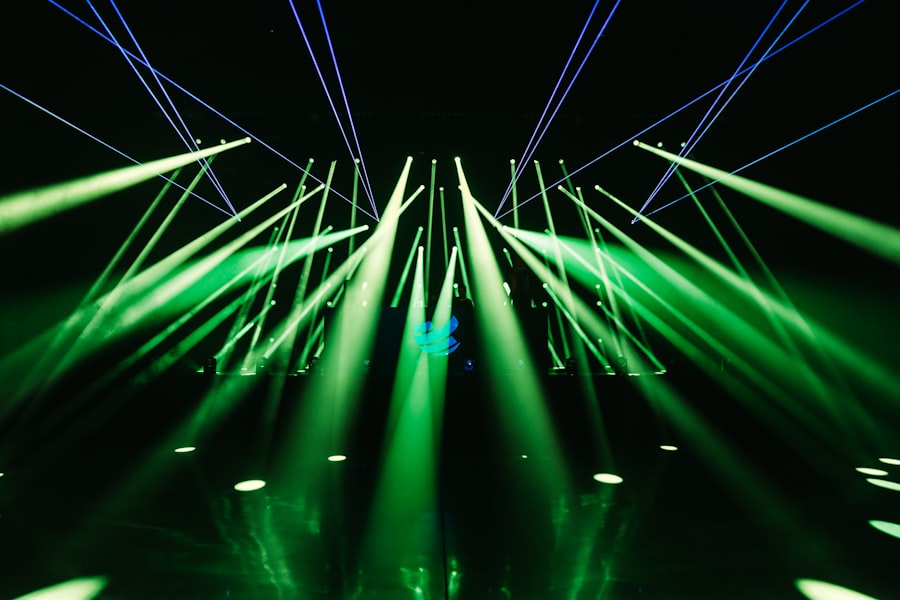Concert photography is a unique blend of artistry and technical skill, requiring you to capture fleeting moments that convey the energy and emotion of live performances. As you step into the world of concert photography, it’s essential to understand the nuances that differentiate it from other forms of photography. The atmosphere at a concert is electric, filled with vibrant colors, dynamic movements, and an audience that is fully engaged.
Your goal is to encapsulate this energy in a single frame, telling a story that resonates with viewers long after the music has stopped. To truly excel in concert photography, you must develop a keen eye for detail and an understanding of the environment. Each concert presents its own set of challenges and opportunities, from the layout of the venue to the behavior of the performers.
You’ll need to be adaptable, ready to adjust your approach based on the lighting conditions, the type of music being played, and the mood of the crowd. By immersing yourself in the experience and observing how different elements interact, you can create compelling images that reflect the essence of the performance.
Key Takeaways
- Understanding the basics of concert photography is essential for capturing the magic of live performances.
- Having the right gear and equipment, such as a fast lens and a camera with high ISO capabilities, is crucial for successful concert photography.
- Lighting and composition play a key role in creating stunning concert photos, so it’s important to be mindful of these elements during a shoot.
- Overcoming challenges like low light and fast movement requires adaptability and quick thinking to ensure you capture the best moments.
- Techniques for freezing action and emotion, such as using a fast shutter speed and anticipating key moments, are essential for capturing the energy of a live performance.
Gear and Equipment: What You Need for Capturing the Magic
When it comes to concert photography, having the right gear can make all the difference in your ability to capture stunning images. A high-quality camera with excellent low-light performance is essential, as concerts often take place in dimly lit environments. You might consider investing in a DSLR or mirrorless camera that allows for interchangeable lenses, giving you the flexibility to adapt to various situations.
A fast lens with a wide aperture (such as f/1.8 or f/2.8) will enable you to gather more light and achieve beautiful bokeh effects, isolating your subjects against a blurred background. In addition to your camera and lenses, don’t overlook the importance of accessories. A sturdy tripod can be beneficial for longer exposures, although it may not always be practical in crowded venues.
Instead, consider using a monopod for added stability while still allowing for mobility. Extra batteries and memory cards are also crucial; concerts can be unpredictable, and you don’t want to miss capturing a pivotal moment because your equipment ran out of power or storage space. By preparing adequately with the right gear, you’ll be well-equipped to seize the magic of live performances.
Lighting and Composition: Tips for Creating Stunning Concert Photos

Lighting plays a pivotal role in concert photography, often presenting both challenges and opportunities. The dynamic nature of stage lighting can create dramatic effects that enhance your images, but it can also lead to harsh contrasts and difficult exposure situations. To navigate this, familiarize yourself with your camera’s settings and practice shooting in manual mode.
This will give you greater control over your exposure settings, allowing you to adjust your aperture, shutter speed, and ISO to achieve the desired effect. Composition is equally important in concert photography. Consider the rule of thirds when framing your shots; placing your subject off-center can create a more dynamic image.
Look for interesting angles and perspectives that highlight the performers’ movements or interactions with the audience. Don’t be afraid to experiment with different compositions—sometimes the most striking images come from breaking traditional rules. By combining thoughtful lighting techniques with creative composition, you can produce concert photos that are not only visually appealing but also emotionally resonant.
Working with the Challenges: Overcoming Low Light and Fast Movement
| Challenges | Low Light | Fast Movement |
|---|---|---|
| Difficulty | High | High |
| Impact on Quality | Decreased | Blurry |
| Recommended Settings | Higher ISO, wider aperture | Faster shutter speed, continuous focus |
| Equipment Needed | Low-light lens, tripod | Telephoto lens, monopod |
One of the most significant challenges in concert photography is dealing with low light conditions while capturing fast-moving subjects. The combination of dim lighting and energetic performances can make it difficult to achieve sharp images without introducing motion blur. To combat this, you’ll need to find a balance between your shutter speed and ISO settings.
A higher ISO will allow you to shoot in lower light but may introduce noise into your images. Experimenting with different settings will help you discover what works best for each venue and performance. Additionally, anticipate moments of action by keeping your camera ready and focusing on key areas where movement is likely to occur.
This could mean tracking a lead singer as they move across the stage or capturing a drummer during an intense solo. Using continuous shooting mode can also help you capture multiple frames in quick succession, increasing your chances of getting that perfect shot amidst the chaos of a live performance. By honing your skills in these areas, you’ll become more adept at overcoming the inherent challenges of concert photography.
Capturing the Energy: Techniques for Freezing Action and Emotion
To truly convey the energy of a concert through your photographs, you must master techniques that allow you to freeze action and capture emotion. One effective method is to use a fast shutter speed—typically 1/250th of a second or faster—to freeze movement without blurring. This is particularly important during high-energy moments when performers leap into the air or engage with the audience.
However, be mindful that using too fast a shutter speed can sometimes strip away the sense of motion; finding a balance is key. In addition to freezing action, capturing emotion is vital for telling a compelling story through your images. Pay attention to facial expressions and body language; these elements can convey powerful feelings that resonate with viewers.
Candid moments between band members or interactions with fans can also add depth to your portfolio. By being present and observant during performances, you’ll be able to anticipate these moments and capture them as they unfold, resulting in photographs that evoke genuine emotion.
Building Relationships: Navigating the Concert Environment and Working with Artists

Make a Lasting Impression
When attending concerts, take the time to introduce yourself and express your passion for music and photography. Being personable and professional can leave a lasting impression that may lead to future gigs or access to exclusive events.
Understand the Venue Dynamics
Moreover, understanding the dynamics of a concert environment will help you navigate it more effectively. Each venue has its own rules regarding photography; some may allow flash while others do not. Familiarize yourself with these guidelines before arriving at an event to ensure you’re prepared.
Foster Positive Relationships
Additionally, being respectful towards artists and their teams will go a long way in fostering positive relationships. By demonstrating professionalism and courtesy, you’ll create an environment where collaboration is possible, ultimately enhancing your concert photography experience.
Post-Processing and Editing: Enhancing Your Concert Photos
Once you’ve captured stunning images at a concert, the next step is post-processing and editing them to enhance their visual impact. Software like Adobe Lightroom or Photoshop can be invaluable tools in this process, allowing you to adjust exposure, contrast, color balance, and sharpness. Start by organizing your photos into folders based on events or dates; this will make it easier for you to locate specific images later on.
During editing, focus on enhancing the mood of each photograph while maintaining its authenticity. Adjusting highlights and shadows can help bring out details that may have been lost in low light conditions. Additionally, consider applying subtle color grading techniques to evoke specific emotions or match the vibe of the performance.
However, be cautious not to over-edit; preserving the raw energy of live music is essential in concert photography. By refining your images thoughtfully during post-processing, you’ll elevate your work while staying true to its original essence.
Sharing Your Work: Tips for Promoting and Showcasing Your Concert Photography
After investing time and effort into capturing and editing your concert photos, it’s time to share your work with the world. Social media platforms like Instagram, Facebook, and Twitter are excellent avenues for showcasing your photography while connecting with fellow music lovers and industry professionals. Create an engaging online portfolio that highlights your best work; consider including behind-the-scenes stories or anecdotes about each performance to draw viewers in.
Networking is also crucial when promoting your concert photography. Attend music events, join photography groups, or participate in online forums where you can share your work and receive feedback from peers. Collaborating with musicians or bands can further expand your reach; offering them high-quality images in exchange for credit on social media can help both parties gain exposure.
By actively sharing your work and building connections within the music community, you’ll increase your visibility as a concert photographer while continuing to grow your skills and portfolio.
